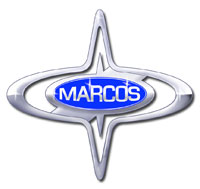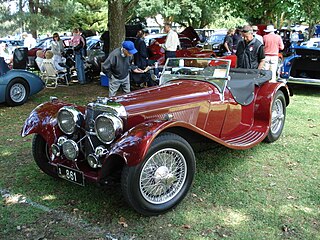
The Ford GT40 is a high-performance endurance racing car designed and built by the Ford Motor Company. It grew out of the "Ford GT" project, an effort to compete in European long-distance sports car races, against Ferrari, who had won the prestigious 24 Hours of Le Mans race from 1960 to 1965. Ford succeeded with the GT40, winning the 1966 through 1969 races.

Lotus Group is a British multinational automotive manufacturer of luxury sports cars and electric lifestyle vehicles.
Caterham Cars Ltd. is a British manufacturer of specialist lightweight sports cars established in Caterham, England, with their headquarters in Dartford, England. Their current model, the Caterham 7, originally launched in 1973, is a direct evolution of the Series 3 Lotus Seven designed by Colin Chapman. In the 1990s the company made the Caterham 21, a two-seater soft top alternative to the MG F and Lotus Elise,. A track-only car, the SP/300.R, a joint project with Lola was released for customer testing in 2010 and was scheduled for release in 2013.

The Triumph Stag is a 2+2 sports tourer which was sold between 1970 and 1978 by the British Triumph Motor Company, styled by Italian designer Giovanni Michelotti.

Marcos Engineering was a British sports car manufacturer. The name derives from the surnames of founders Jem Marsh and Frank Costin.
Westfield Sportscars is a manufacturer of both factory built and kit versions of several two-seater, open top sportscars. Their main product is a Lotus Seven inspired car – vehicles originally designed by Colin Chapman with only the bare essentials for motoring in order to give the rawest and most exhilarating driving experience.

The Caterham 7 is a super-lightweight sports car produced by Caterham Cars in the United Kingdom. It is based on the Lotus Seven, a lightweight sports car sold in kit and factory-built form by Lotus Cars, from 1957 to 1972.

The Land Rover Discovery is a series of seven-seater family SUVs, produced under the Land Rover marque, from the British manufacturer Land Rover, and later Jaguar Land Rover. The series is currently in its fifth iteration, the first of which was introduced in 1989, making the Discovery the first new model series since the launch of the 1970 Range Rover – on which it was based – and only the third new product line since the conception of the Land Rover by Rover in 1948. The model is sometimes called influential, as one of the first to market a true off-road capable family car.

The Land Rover Defender is a series of British off-road cars and pickup trucks. They consistently have four-wheel drive, and were developed in the 1980s from the original Land Rover series which was launched at the Amsterdam Motor Show in April 1948. Following the 1989 introduction of the Land Rover Discovery, the term 'Land Rover' became the name of a broader marque, and thus no longer worked as the name of a specific model; thus in 1990 Land Rover renamed the 90 and 110 as Defender 90 and Defender 110 respectively. The 127 became the Defender 130.

The Rover V8 engine is a compact OHV V8 internal combustion engine with aluminium cylinder block and cylinder heads, designed and produced by Rover in the United Kingdom, based on a General Motors engine. It has been used in a wide range of vehicles from Rover and other manufacturers since its British debut in 1967.

The SS Jaguar 100 is a British 2-seat sports car built between 1936 and 1939 by SS Cars Ltd of Coventry, England. The manufacturer's name 'SS Cars' used from 1934 maintained a link to the previous owner, Swallow Sidecar, founded in 1922 by Walmsley and Lyons to build motorcycle sidecars. In March 1945 the S. S. Cars shareholders agreed to change the name to Jaguar Cars Limited.

Ginetta Cars Limited is a British specialist builder of racing and sports cars based in Garforth, Leeds, West Yorkshire.

The LDV Pilot was the last of a series of a panel vans that was produced by from 1974 until 2005, originally as the 1974 Leyland Sherpa developed by the Austin-Morris division of British Leyland, which was in turn derived from earlier light commercials produced by the British Motor Corporation.

The Land Rover Series I, II, and III, or simply the Land-Rover are compact British off-road vehicles, produced by the Rover Company since 1948, and later by British Leyland. Inspired by the World War II jeep, it was the first mass-produced civilian four-wheel drive car with doors, and an available hard roof. Contrary to conventional car and truck chassis, it used a sturdier fully box-welded frame. Furthermore, due to post-war steel shortage, and aluminium surplus, Land Rovers received non-rusting aluminium alloy bodies, favouring their longevity. In 1992, Land Rover claimed that 70% of all the vehicles they had built were still in use.

Engines used by the British company Land Rover in its 4×4 vehicles have included four-cylinder petrol engines, and four- and five-cylinder diesel engines. Straight-six cylinder engines have been used for Land Rover vehicles built under licence. Land Rover has also used various four-cylinder, V8, and V6 engines developed by other companies, but this article deals only with engines developed specifically for Land Rover vehicles.

The TVR M series is a line of sports cars built by automaker TVR between 1972 and 1979. The series replaced the outgoing TVR Vixen and Tuscan models, and is characterized by a common chassis and shared body style. As with other TVR models before and since, the M-series cars use a front mid-engine, rear-wheel drive layout and body-on-frame construction. The bodies themselves were built from glass-reinforced plastic (GRP). The era of the M series is commonly associated with Martin Lilley who, together with his father, took ownership of the company on 30 November 1965.

The Land Rover Range Rover, generally shortened to Range Rover, is a 4x4 luxury SUV produced by Land Rover, a marque and sub-brand of Jaguar Land Rover. The Range Rover line was launched in 1970 by British Leyland and is now in its fifth generation.

Gardner Douglas is a British low volume sports car manufacturer, based in Grantham, Lincolnshire, England. Their models include replicas of the AC Cobra and the Lola T70.

The Land Rover Range Rover (LP), generally shortened to Range Rover, is the second-generation Range Rover model from British car maker Land Rover. It was launched on 28 September 1994, 24 years after the introduction of the Range Rover Classic. It included an updated version of the Rover V8 engine, with the option of a 2.5-litre BMW six-cylinder turbo-diesel. The new model offered more equipment and premium trims, positioning the vehicle above the Land Rover Discovery to face the increased competition in the SUV marketplace.

The Cooper T86 was a Formula One racing car built by Cooper and first raced in 1967. B and C specification cars were also built to accommodate different engines, but the car could not revive Cooper's fortunes and this type represents the last Formula One chassis built and raced by the former champion team.


















